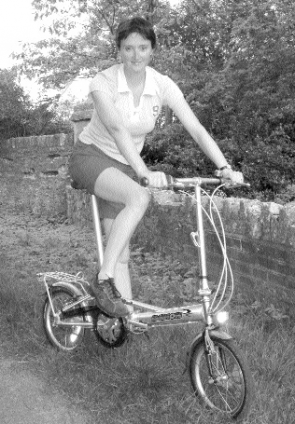
The Presto is probably the most conventional looking of the three
If you’re a regular commuter, whether by train, car or bus, you could almost certainly use a quality folding bike.You may not realise that yet, but it’s probably the case nonetheless. A folder makes commuting more flexible, allowing you (for example) to hop off the train in a cheaper fare zone, take a different route when your line is closed, eliminate tube fares or station parking, or park- and-ride from the edge of the city. Everybody should have one, and the classic machines include the Brompton, or – if you prefer 20-inch wheels – a Dahon (typically the Helios), or the Giant Halfway.
None of these bikes are cheap, so we’re looking at three cut-price compacts: the Pashley Micro-Luxe, still only £295, the new Dahon Presto P3 at £345, and Brompton’s bargain basement C3 at £375. All three bikes have 16-inch wheels (the larger ‘British’ 347mm size on the Micro and Brompton, and smaller 305mm on the Dahon), and all fold into compact packages, although not quite the bus-friendly folded size of the Brompton L-type. But they’re much cheaper, and on paper at least, should do a similar job. Is this true?
It’s been a few years since we produced a group test of folding bikes, and we’ve never tried the Brompton C3, although the Brentford factory has been quietly producing this cheaper variant for several years. Basically, the C3 is a Brompton frame with inferior bits and pieces hung on it, with the exception of mudguards (there aren’t any), and it comes in any-colour-you-like as long as it’s red. A word of caution – we wouldn’t recommend buying a C3 with the intention of upgrading it to L6 spec when funds allow, because the cost would be prohibitive. However, the C3 accepts Brompton’s pannier system and with these sort of extras, it might be worth considering as a fine weather commuter bike.
The Presto is new, and one of a bewildering range of new and revamped models to arrive from Dahon’s Chinese factory in recent months.The frame is effectively a smaller version of the 20-inch Helios frame we admired in A to B 31, but almost everything else is new, or at least, new to us.
The Micro is one of the great survivors of the folding bike world, having been in more or less continuous production in a number of guises since its birth in Birmingham back in 1976.The bike has been produced by Pashley for a number of years now, but the company has made few changes, other than safety modifications and a change to a SRAM hub when Sturmey ceased to exist. Our test bike is actually a few years old, but can be treated as a new machine in most respects.
The Contenders
Despite their diminutive size, all three of these bikes can be adjusted to fit most riders, with the Dahon being the most adaptable and the Micro the least. If you’re very tiny, you’ll be delighted to hear that the Brompton can be ridden with the saddle only 65cm from the ground, but less pleased to hear that the Micro only drops to 74cm, and the Presto to 85cm. For the very tall, it’s more or less the other way around – 94cm for the Micro or Brompton and a useful 101cm on the Presto. Just to confuse matters, the Brompton leaves the factory with the saddle right forward and as low as it will go. Reverse the saddle bracket and fix the saddle at the very top of the stem, and you’ll find another centimetre or so, at the expense of a slightly taller folded package.The Brompton is also available with a taller saddle stem, or two-stage telescopic device, but that adds to the cost, weight and folded volume.
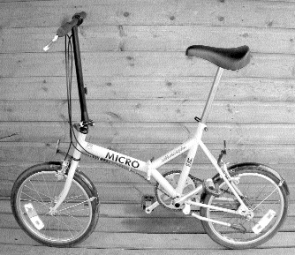
The Micro-Luxe - quirky looks and handling
Handlebar height is only adjustable on the Presto, in a range 84 – 101cm, the others being fixed at a reasonably comfy, if rather upright stance. Reach from the saddle to the bars obviously varies with saddle (and/or bar) position, but it’s greatest on the Presto at 52cm – 60cm (considered too much by some), and around 48 – 51cm for the Micro and Brompton. Generally speaking, the Presto is a bit stretched for the very small, but the best choice for those of six-foot plus.
Weight is almost as important as ride quality with compact machines, and when you’ve dashed from Platform 1 to Platform 14 a few times, you’ll begin to appreciate why.Winner here is the Micro at 11kg, followed by the Brompton at 11.3kg, and the light alloy, but more generously equipped Presto topping the scales at 11.6kg. If they all sound a bit heavy, Pashley claims it can produce a 9.5kg single- speed version of the Micro to order; Brompton says the C3 can be trimmed to 10.7kg with some pricier bits, and Dahon has just withdrawn a delightful single- speed version of the Presto, weighing a claimed 7.9kg.You might find one if you’re lucky, but you’ll have to pay £450. Most of the bigger, better folding bikes cost more than this, and they tend to weigh more too: 11.4kg for the Brompton L3, 12.2kg for the Dahon Helios, and 12.6kg for the Giant Halfway.
…if you can live with these quirks, you may be very happy together…
Ride
Although it bears a family resemblance to the very sweet Dahon Helios, the little Presto proved a bit disappointing. Despite having the lowest gear ratios by a small margin, the smaller 305mm tyres make the bike feel slightly over-geared and lethargic.This effect is made worse by a degree of lateral flex in the main frame tube. On the positive side, the long 102cm wheelbase helps to smooth out any choppiness on poor road surfaces, and the saddle stem feels rigid fore and aft, so you can put in plenty of effort, provided you avoid twisting the machine.The handlebar stem would be rigid enough, but the joint feels loose, and despite greasing the moving parts, and adjusting the stop, we couldn’t eradicate this. And once in a while, the hinge appeared to latch, but was only partially fastened. Generally speaking, if the hinge mechanism is hidden, as it is here, it’s worth checking that things really have engaged properly before riding away. Of Doctor Hon’s many designs, this is not the best.
The Micro is a strange beast. Initially it feels highly unstable (‘wonky’ is a common complaint), but if you persist, that impression soon fades.The wonkiness is partly the result of a rather spindly front end and short 89cm wheelbase, but mainly due to the bars being well forward of the steering axis. Consequently, the handling is always going to be strange, but most people learn to live with it.The frame is solid enough at the rear, but that stem really is as frail as it looks, so the only practical technique is to sit upright and spin the pedals smoothly, putting as little weight on the bars as possible: much the same as riding the old Bickerton. If you can acclimatise yourself, the Micro can be quite a rewarding bike to ride, but the short wheelbase means you have to take a little care, and rough surfaces are beyond its capabilities. If you can live with these quirks, you may be very happy together, but if you can’t, you’ll hate it.
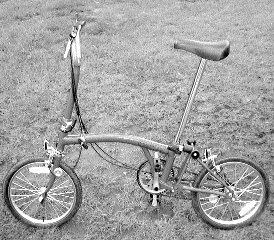
The Brompton C3 - economy version of the Brompton L and T models
The Brompton is the most rigid of the three, with something of a ‘proper’ big bike feel, and despite much higher gearing (still some 10% lower than the conventional Brompton), it feels sprightly and fun to ride.At 101.5cm, the wheelbase is almost as long as the Dahon, the frame is stiff, but entertainingly lively, and the rear suspension absorbs bumps quite well.The result is a machine that handles tricky canal towpaths and off-road trails with surprising ease – the lack of mudguards helps here, although lower gearing would be an advantage if the bike was to spend any time off-road. Read more about action ac.
 None of these bikes are great hill-climbers. Despite a bottom ratio of 44 inches, the Brompton does best, because it’s rigid enough for you to stand out of the saddle on steep hills.With a bottom gear of 40 inches and a reasonable frame, the Dahon isn’t far behind, but the little Micro is limited to the sort of gradients that can be climbed with your bottom very firmly on the saddle. Standing out of the saddle on a Micro is an acquired art, and not an especially productive one.Top speed depends on how fast you can twiddle the pedals with a 75-inch top gear (Micro and Presto) and 82-inch gear (Brompton).
None of these bikes are great hill-climbers. Despite a bottom ratio of 44 inches, the Brompton does best, because it’s rigid enough for you to stand out of the saddle on steep hills.With a bottom gear of 40 inches and a reasonable frame, the Dahon isn’t far behind, but the little Micro is limited to the sort of gradients that can be climbed with your bottom very firmly on the saddle. Standing out of the saddle on a Micro is an acquired art, and not an especially productive one.Top speed depends on how fast you can twiddle the pedals with a 75-inch top gear (Micro and Presto) and 82-inch gear (Brompton).
The best sixteen-inch rolling resistance is broadly comparable to a typical big-wheel bike these days, but there’s no special tyre technology on these budget machines.The Brompton wins the booby prize, with 1960s- vintage Raleigh Records, although the other models are fitted with the company’s own excellent tyres these days.The Micro used to come with useless Swallow tyres, but they went out of production, forcing Pashley to spend a few quid on their replacement – the good-all-rounder Schwalbe Marathon. Get the feeling the Micro is starved of investment? Dahon fits a pair of Kenda Kwests – another safe bet. In terms of rolling resistance, measured on our standard test hill, all three managed a shade over 13mph, or about one mile per hour behind the best 16-inch flyers. If anything, the Dahon seemed to have a slight edge, despite having the smallest tyres.
Brakes
Never were a group of bikes more widely separated. Both the Brompton and Micro are fitted with horrible side-pull callipers that should have become extinct several decades ago, but seem to have survived in this base-model Lost World.This, together with nondescript levers and long cables of dubious quality, results in some truly scary braking performance, even in ideal conditions.
Worst of all is the Brompton – mainly because the callipers and levers are so flexible that a crash stop results in the levers meeting the handlebars long before an acceptable brake force has been applied. On our test bike, the rear brake managed a stop of .27G (some way short of locking the wheel), while the front achieved a desultory .35G – not much risk of being thrown over the handlebars there. Heaving both levers right to the bars produced a panic stop of .48G, which just locks the rear wheel.That’s a sufficiently poor performance to be dangerous with heavier riders, or in busy city traffic. Once again, all other Bromptons are fitted with much improved dual- pivot brakes.
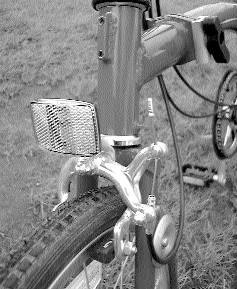
The Brompton C3 has the worst brakes of the group. Note the mounting block for the carrier system
The Micro has marginally better Tektro levers, but similar Saccon callipers to the Brompton.The rear brake did even worse, with a mean performance of only .25G, a rotten stop, made only slightly more interesting by a strange harmonic, which runs up through the frame and into your private parts. Strange but true. The front brake lacks the entertaining massage effect, but makes up for it with a modest stop of .52G.That’s not enough to lift the rear wheel, but considering the short wheelbase, it’s probably close enough for comfort, so improved callipers wouldn’t C3 necessarily make the bike any safer. Both brakes resulted in a stop of .6G, which is adequate, but far from heart-stopping.
In marked contrast, the Presto comes with Dahon-branded V-brakes, excellent Jagwire cables and Promax levers.The result is brake performance as close to a hydraulic system, in terms of performance and feel, as cable-operated brakes are likely to get.The cables flow through their guides almost without resistance, and when the brakes bite, they do so progressively and with real power.
The front to rear weight distribution must be good too, because we achieved an excellent .41G stop at the rear before the wheel locked up.Yes, that’s almost as good as heaving on both the Brompton anchors. Obviously there’s enough power here to lift the rear wheel with ease in a front brake stop, but the long wheelbase keeps things well under control. As the wheel starts to lift, the front brake hits a maximum of .75G, which is the best result we’ve achieved in our short experience of G-meters. It’s also better than the Orbit Orion tested elsewhere in this issue, which rather overturns the widely held belief that small-wheel don’t stop as well as big ones… Given similar technology, they stop just as well, or better.
Accessories
Dahon again, by a wide margin. The Presto has a pair of Next folding pedals (strange, because it only needs one), a smart little rack, a bell and a stand.The Micro has a pair of frightful VP-112 folding pedals (strange again) and a stand.The Brompton has nothing, except that wonderful Brompton frame. In terms of aftermarket fitments, there’s a mounting plate for the Brompton front carrier system, and another useful accessory is the folding pedal. But that comes as standard on the L- or T-type, together with proper brakes, decent tyres and so forth…You pays your money and takes your choice.
Folding
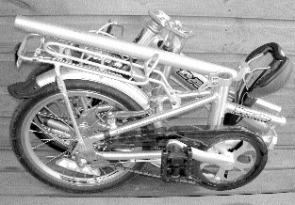
The Presto is the most difficult to fold, producing an untidy package
In folding tests, the Brompton always wins. The secret is a clever frame that folds and rotates back on itself around the steering head, producing easily the neatest, and marginally the smallest, of the three folded packages at 124 litres (4.4 cubic feet). And that’s with the left-hand pedal sticking out. Once you’ve learnt to do things in the right order, which is essential, it’s all very straightforward, with a quick-release for the saddle stem and two big user-friendly U-clamps on the frame and stem joints.The folded package is marginally taller than the others at 56cm, and about the same width at 35cm (thanks to that protruding pedal) but at 60cm, it’s much shorter.
The Dahon frame folds around a robust-looking hinge, while the other (less satisfactory) hinge allows the handlebar stem to tuck down between the two frame halves. A quick-release drops the saddle stem, which can be left rather untidily in place or removed, while another quick-release on the handlebar stem must be loosened and re- tightened to allow the bars to assume their most compact position.This tricky manoeuvre proves the bike’s Achilles heel and results in all sorts of confusion for those unfamiliar with folders. A lock-nut on the quick-release would help, because the adjustment keeps changing, and needs constant fettling and fiddling. Get it wrong and the bars can drop right out of the folded package, or worse still, swivel round while you’re riding away. Get it right, and the Presto produces a near C3 folded package of 129 litres – 75cm long, 35cm wide, and 49cm tall (with the saddle stem stowed between the frame halves).
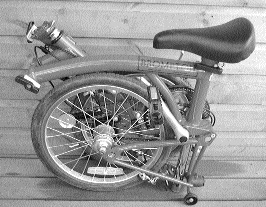
The Brompton is by far the neatest and quickest folder
The Micro is the simplest and/or crudest design, relying on a pair of rather frail- looking Brompton-style hinges, allied to the simple frame geometry of the Dahon. However, the Micro can be folded in any order, because the bars end up on the outside of the package – a much easier concept for beginners to grasp.There’s no handlebar height adjuster, and a simple quick-release to lower the saddle stem.The resulting package is a little wider than the Dahon at 36cm, taller at 51cm, but shorter at 71cm, producing a slightly bigger package of 130 litres.
Once folded, the Brompton is effectively locked together until the next time the saddle is lifted.The Micro and Dahon are not quite so clever, the Micro being secured in the folded position with a couple of domestic water- pipe clips, and the Dahon with an easily mislaid bit of Velcro.There’s no obligation to remove the saddle stem with either, but if you don’t, the package will be taller: 64cm for the Micro (producing a 168 litre package) and 68cm for the Presto, resulting in a rather cumbersome 178 litres.
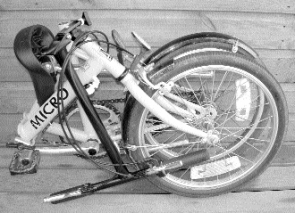
The Micro is the crudest design, but it works reasonably well
On paper, the three bikes might appear similar, but folding the Brompton is much more consistent. Once you’ve got the hang of it, the elements clonk down into exactly the same place each time and lock in place. Unfold the Brompton, and everything goes back where you left it the last time the bike was used. It’s a simple, reliable mechanism that can be repeated time and again, without trapped fingers or cables, and it’s as easy to do on a cold wet night as your train arrives, as it is on a Sunday morning in the park.
Fit a folding pedal to the Brompton, and the width comes down to 27cm, reducing the package size to 90.7 litres, or about 3.2 cubic feet.With a few compromises on riding position, caravanners, pilots and yachtsmen with cramped locker space can jiggle the length, width and height down a little further, producing a folded package of less than 85 litres, or three cubic feet.
Folding times are largely irrelevant in the leisure market, but the stuff of missed appointments and supper (or partner) going off the boil for commuters. Once again, the Brompton dominates: Provided you ride the bike with the saddle at its upper stop height, the C3 can be folded up or down in about 12 seconds (we managed a record of eight, but we know the bike well). Unfolding takes a second or two longer, because of the need to set the saddle alignment, but thanks to a height stop, everything else should wind up precisely in place.The Micro is superficially similar to the Brompton, but the need to remove the saddle stem adds a bit of time, making about 24 seconds in all. Unfolding takes about the same time, including setting the saddle stem height and alignment.
The Presto languishes in the 50 second zone – mainly because of the need to loosen the handlebar stem, then re-tighten it in the folded position; remove the saddle stem and stow it; then wrap the Velcro round. Unfolding can take even longer, because both the saddle and handlebar height and alignment must be set before riding off.
Conclusion
Before reaching our own conclusions, it’s worth summarising the views of our small panel of ‘conventional’ cyclists. At first glance, the Micro was dismissed, because of its dumpy appearance and short wheelbase.The slightly odd-looking Brompton was also treated with suspicion and the Dahon faired best, being considered the smartest and most conventional of the three bikes. A brief ride tended to produce much the same result – Dahon on top, closely followed by Brompton, with the Micro trailing behind. But folding changed everything, with even the beginners rating the Brompton best of the bunch, the Micro second, and the Dahon last.
Are these machines practical commuter bikes? Our advice with the Micro is to try it and see if you can live with the quibbles and quirks. If you can, you’ve found a compact, light and very economical folding bike. If you can’t, you’ll have to spend more…The short and the tall will prefer the Dahon, thanks to its adjustability, but for most commuting purposes, the folding is too clumsy, although a simple car park-and-ride journey shouldn’t prove too taxing. But if you want a Dahon, the 20-inch models are cheaper, easier to fold and much nicer to ride.
And the Brompton C3? It’s a jolly little bike, but you get the feeling there’s a much better machine trying to get out, which of course there is: the Brompton L-type.The L3 costs 25% more than the C3, but it’s probably the best commuter bike on the planet, so there’s no contest. Save up for the real thing…
Specification
Pashley Micro-Luxe £295
Weight 11kg (24.2lb)
Folded Volume Stem removed 130 litres
Folded size L71cm H51cm W36cm
Gear system SRAM 3-speed hub
Ratios 41″ 56″ 76″
Manufacturer Pashley Cycles tel 01789 292263 web www.pashley.co.uk
Dahon Presto P3 £345
Weight 11.6kg (25.5lb)
Folded Volume Stem removed 129 litres
Folded size L75cm H49cm W35cm
Gear system SRAM 3-speed hub
Ratios 40″ 55″ 75″
Manufacturer Dahon web www.dahon.com
UK distributor Cyclemotion tel 0800 585405 mail sales@cyclemotion.co.uk web www.dahon.co.uk
Brompton C3 £375
Weight 11.3kg (24.9lb)
Folded Volume 124 litres
Folded Size L60cm H56cm W37cm
Gear system SRAM 3-speed hub
Ratios 44″ 60″ 82″ . Manufacturer
Brompton Bicycle tel 020 8232 8484 web www.bromptonbicycle.co.uk
![]()
